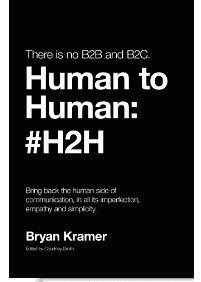Differentiate Between Touch Points and Sentiments

By Bryan Kramer
Are people and brands so time pressed they can’t separate their ask while giving a sentiment? Do they see everything as an opportunity? We live in a world where social media has enabled us to connect with each other at any given moment. The only thing is, sometimes it’s hard to understand when a moment is the right moment to simply reach out, or when to include wanting something for yourself.
I wonder whether people really know the difference between a touch point vs a sentiment. A touch point is letting other people know we are here and that we want to stay top of mind for business. A sentiment is a heartfelt expression we give (emphasis on GIVE ) to someone to let them know how we feel. When you combine the two, however, it turns into a confusing message that’s hard to interpret.
) to someone to let them know how we feel. When you combine the two, however, it turns into a confusing message that’s hard to interpret.
Let me give you an example. On my birthday in October, I had so many wonderful birthday wishes shared with me in social media, I was overwhelmed and so grateful. The thing is though, there were some people as individuals, and some representing brands, that reached out to wish me a happy birthday as a touch point wrapped inside a sentiment. “Happy Birthday, Bryan! I would love it if I could send you my [insert product here.]/[call me about that meeting]/[I’m looking for a job.]” There were moments when I thought to myself, “is this really what it’s come to?” This experience was a nice reminder that the words that we use and how we use them and when we use them, they matter.
Now don’t get me wrong, when somebody reaches out in the human to human way it makes me want to connect more. A simple gesture, a moment of inspiration or simply saying hi. But when brands or people reach out through automation OR in an insincere way that is clearly not personalized to me, it simply breaks my trust for that brand or person.
As we work on our individual and company brands, it’s never been more important to know the right way to reach out. If it’s a client, wish them a happy birthday. Wish them a happy anniversary. Or wish them success. But whatever you do, make sure that you’re not using a personal milestone as an excuse to remind them about what you do or what you need from them.
Here are some pointers to know that you’re separating touch points from sentiments:
- If somebody is celebrating something special, it’s not a good time to propose a business interaction of any kind, period.
- If you want to communicate as a brand, find a unique way of letting people know you care (without being creepy). Mass printing a birthday card with my name doesn’t work anymore.
- Touch points should happen year round; a sentimental moment shouldn’t serve as the time connect with someone for business.
- Giving a sentiment does not mean that they owe you one back. You should give to give, not give to get.
- There isn’t anyone in this world who doesn’t want to receive love or connection, so be sincere and make it about them.
KEY TAKEAWAY: At a very basic level of connecting with people, look at your communication and ask yourself, “how can I personalize this response to another human being? How would I like this posed to me?” You will always have a greater impact if you make it about them. Mass messaging is about YOU trying to save time. And if you think trying to sell, using a personal emotional moment as a Trojan horse will work, rethink your strategy; take a step back and ask yourself, “is this the right time, and what I really want to say to them at this moment?” Being genuine will always be more memorable.
 Bryan Kramer is a Social Business Strategist and CEO of PureMatter where he’s led his agency to consistent growth over the last 10 years earning a spot as one of Silicon Valley’s fastest growing private companies. Bryan is also an author of the book There is No B2B or B2C: It’s Human to Human #H2H.
Bryan Kramer is a Social Business Strategist and CEO of PureMatter where he’s led his agency to consistent growth over the last 10 years earning a spot as one of Silicon Valley’s fastest growing private companies. Bryan is also an author of the book There is No B2B or B2C: It’s Human to Human #H2H.
About Book
In Human to Human #H2H, Bryan explores the many facets of why and how communication today needs to be adjusted to keep up with our ever-evolving and fast moving social and digital world. Through anecdotes from his own experiences as president of a Silicon Valley marketing firm, he both inspires new ways of finding commonality in our humanity, but also practical tools to think like a human marketer again. Order here from Amazon.
Originally published on bryankramer.com, entitled “The Difference Between a Touch Point and a Sentiment” and re-published here with permission,
Images: https://www.nitrd.gov/subcommittee/pca-definitions.aspx
Photo Credit: Charis Tsevis
Jan Gordon
Latest posts by Jan Gordon (see all)
- Curatti Best Articles of 2022 (And Happy New Year 2023!) - December 28, 2022
- Curatti Best Articles of 2021 (And Happy New Year 2022!) - December 31, 2021
- Curatti Best Articles of 2020 (And Happy New Year 2021!) - December 31, 2020

